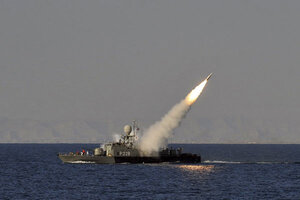Iran test-fires new missile as Strait of Hormuz posturing continues
Iran test-fired a new Qader missile today in the latest bout of martial posturing over the country's nuclear program and the security of the Strait of Hormuz, a crucial shipping lane for oil.

This Iranian government handout purports to show an Iranian vessel launching a missile in the Gulf of Oman.
Iranian Students News Agency
• A daily summary of global reports on security issues.
In a demonstration likely designed to intimidate the US and Israel, Iran test fired two missiles as part of a 10-day military exercise on Monday.
With these missiles, Iran could target regional US bases. The military display was also designed to demonstrate Iran’s ability to close of the Strait of Hormuz, through which 20 percent of the world’s oil passes.
As speculation intensifies that the US and Israel are conducting a covert war against Iran, and the West is threatening to impose further sanctions, the Islamic Republic has said it is enhancing its defenses.
The West and Israel have lately increased pressure on Iran to stop its nuclear program, which they say is designed to make nuclear weapons. Iran says is it is strictly for meeting its electricity needs.
With a range of 200 kilometers, Iran’s new Qader sea-launched cruise missile comes as part of a program “to beef up the country's defense capabilities against potential enemies,” reports Iran’s Press TV. The missile was first unveiled in late August and the nation began mass production in late September.
“In comparison with the previous version, the highly advanced Ghader missile system has been upgraded in terms of its radar, satellite communications, precision in target destruction, as well as range and radar-evading mechanism,” the Associated Press quoted Rear Adm. Mahmoud Mousavi, an Iranian military spokesman, as saying.
Iran has described these missiles as “long-range,” but missiles with the reach of the Qader are generally considered medium- to short-range missiles, even by comparison to others produced by Iran.
“This is not by any means the longest-range missiles that the Islamic Republic possesses,” reports Al Jazeera's Dorsa Jabbari. “We know that back in 2009 Sejil-2 was unveiled and it has a range of 2,000km. At the time they said it was capable of reaching various targets in Europe and also Tel Aviv.”
Saber rattling accompanied the missile launch. The secretary of Iran's Supreme National Security Council, Saeed Jalili, warned that his nation would deliver a “harsh response to any threat,” according to the Iranian Students’ News Agency.
Although Iran’s President Mahmoud Ahmadinejad has said he will respond with “strength” to any new sanctions, there is some skepticism about how strong a response he can afford. Though Iran says it’s not being hurt by the sanctions, its currency has lost 53 percent of its value against the dollar over the past year. If Iran closed off the Strait of Hormuz in response to sanctions, Agence France-Presse reports that it would risk hurting its economy even further, losing the support of China and Russia and starting an open war with the US.
“No order has been given for the closure of the Strait of Hormuz. But we are prepared for various scenarios,” said Iran’s Navy chief Habibollah Sayyari in an article by Reuters.
Still, Iran’s recent naval exercises included a drill meant to simulate shutting down a waterway, reports Reuters. The move likely comes as part of a game of diplomatic brinksmanship with Iran threatening to deal an economic blow to the US and the US and its allies still not ruling out military options if diplomacy fails.

